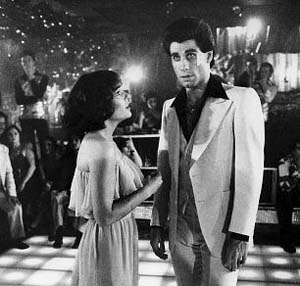I am glad I finally saw this movie now instead of when it was new or during its first 20-25 years of existence. Much like all pieces of Pop Culture, Fever was loved at first then reviled followed by a revival thanks to the Hipster Twins known as the Retro and Kitsch Fads—they appear within every generation. This year is its 30th anniversary and when I was researching Roger Ebert, I read a bit about his former partner Gene Siskel. Fever was Siskel’s favorite film and everyone knows he owned the famous iconic white suit. As much as I disagreed with Siskel’s reviews, especially his hypocrisy on 1941, I don’t think he would take a stand on a “Disco” movie lightly. I wondered what did he see in this flick.
Tony Manero is a stereotypical 18-25 year-old Italian-American Brooklynite: he has little education, he works at a paint store, he lives with his parents, he uses ethnic slurs, he belittles women, etc. When it’s Saturday night, he puts on his upscale clothes and goes to the local discotheque where he’s the king of the dance floor and women are attracted to him.
The primary story is about preparing for the local club’s dance contest. His regular dance partner Annette “has a thing for him,” which annoys him. When he sees Stephanie dancing, he is smitten but more importantly he knows she’s a better dancer so Tony dumps Annette. Stephanie thinks Tony’s an immature goombah because she’s a bit older, works in Manhattan and does an excessive amount of name dropping to illustrate her “superiority;” it doesn’t work, Tony and his friends only recognized Joe Nameth. Despite Tony’s advances, they agree to stay focused on rehearsing. Then comes the culmination with the competition and unlike Strictly Ballroom there’s no big number resulting in a happy ending. Instead Tony has an ugly epiphany during the rest of the evening about his neighborhood, his friends, Joey’s suicide (it’s not a spoiler if the movie is over a decade old) and his future. Tony then takes a long walk from Brooklyn to Manhattan, a dangerous decision in the Seventies, mulls over his possibilities and asks for Stephanie’s help to become a better person.
Meanwhile there are numerous other subplots: Tony’s unemployed father is a source of tension at home; his older brother quitting the priesthood is a pall of shame to his parents; his friend Gus is mugged by Hispanic rivals; his other friend Joey doesn’t want to marry the woman he impregnated; and his clique’s misadventures around Brooklyn, namely the famous bridge. Most of these go unresolved, they’re mainly used to give the movie authenticity since Brooklyn is an alien microcosm to rest of the world.
The ending is anti-climatic, inconclusive and a downer by today’s standards yet most movies in the Seventies were that way: The Parallax View, Rollerball and Chinatown. It was also loosely based upon a magazine article explaining the Disco culture of New York so it wasn’t firmly rooted in a novel. I feel the proper context for Saturday Night Fever is to put it in the same vein as Dazed and Confused, Trainspotting and Less Than Zero. None of these four films have traditional narratives with a conflict and a resolution, they’re glimpses into a particular moment of time and space on certain people, nothing more. It’s just a coincidence they all have drug usage in them too.
I think Gene Siskel and others genuinely liked this movie for showing a working-class guy being elevated to celebrity status one night a week out of his dreary existence. The details were important too. His local discotheque isn’t a glamorous place like Studio 54 or Osko’s, it’s a converted warehouse with tables, a DJ area and one of those floors with lights underneath it. The real Brooklyn neighborhood with its beaten-down look was used to show how the Recession of the Seventies was really taking its toll, making it a place of little hope. After 30 years, Fever has matured into a solid, interesting time capsule of a decade and Travolta’s dancing was impressive even if Disco music is annoying.

